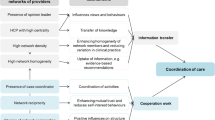Summary
The German “GKV-Modernisierungsgesetz” offers new opportunities for patient care. The concept of “integrated care” provides organizational structures for an standardized treatment of myocardial infarction by bridging the different sectors of the German health care system. Apart from guideline-based therapy, innovative diagnostic (cardiac MRI) and therapeutic (drug-eluting stents) techniques are implemented in the “integrated care” model as well. The “Herzinfarktverbund Essen” is the first national real world experience of the integrated care concept in the treatment of myocardial infarction.
Zusammenfassung
Im Rahmen des GKV-Modernisierungsgesetzes sind neue Wege der Patientenversorgung möglich. Die Integrierte Versorgung ist eine der Möglichkeiten als Einrichtung einer einheitlichen Versorgungsstruktur zur Behandlung von Patienten. In der leitlinienorientierten Therapie der akuten Myokardinfarkte ist eine solche sektorübergreifende integrierte Versorgung von Vorteil. Die Versorgungskette wird am Beispiel des Herzinfarktverbunds Essen in der gesamten Breite des Sektors ambulant, stationär und in der Rehabilitation dargestellt. Ein wichtiges Merkmal des Modells ist die Garantieleistung und die Einführung innovativer Techniken im Rahmen der Akutbehandlung.
Similar content being viewed by others
References
Simonetti OP, Kim RJ, Fieno DS et al (2001) An improved MR imaging technique for the visualization of myocardial infarction. Radiology 218:215–223
Kim RJ, Fieno DS, Parrish TB et al (1999) Relationship of MRI delayed contrast enhancement to irreversible injury, infarct age, and contractile function. Circulation 100:1992–2002
Wu KC, Zerhouni EA, Judd RM et al (1998) Prognostic significance of microvascular obstruction by magnetic resonance imaging in patients with acute myocardial infarction. Circulation 97(8):765–772
Bruder O, Waltering KU, Hunold P et al (2005) Detection and characterization of left ventricular thrombi by MRI compared to transthoracic echocardiography. Rofo. Mar 177:344–349
Popma JJ, Leon MB, Moses JW et al (2004) Quantitative assessment of angiographic restenosis after sirolimuseluting stent implantation in native coronary arteries. Circulation 110(25):3773–3780
Zahn R, Hamm CW, Zeymer U et al (2004) “Real life” use of sirolimus-eluting coronary stents in Germany. Results from the prospective multi-centre German Cypher Registry. Z Kardiol 93:287–294
Author information
Authors and Affiliations
Corresponding author
Rights and permissions
About this article
Cite this article
Sabin, G.V., Bruder, O. Integrierte Versorgung am Beispiel des Herzinfarktverbundes Essen. ZS Kardiologie 94 (Suppl 4), iv90–iv93 (2005). https://doi.org/10.1007/s00392-005-1419-3
Issue Date:
DOI: https://doi.org/10.1007/s00392-005-1419-3
Key words
- “integrierte Versorgung”
- guideline-based treatment of STEMI
- “Modernisierungsgesetz”
- Integrated care
- cardiac MRI (CMR)




